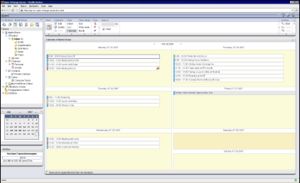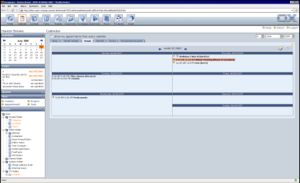Versioning and Numbering: Difference between revisions
| Line 23: | Line 23: | ||
|<generation> | |<generation> | ||
|The first number is the product generation number. A new generation may contain new architecture, different technology and many more. | |The first number is the product generation number. A new generation may contain new architecture, different technology and many more. | ||
|6. (former OX 6) | |<font color="#008000">6.</font><font color="#FF0000"> (former OX 6)</font> | ||
|- | |- | ||
|<major release> | |<major release> | ||
Revision as of 08:00, 3 March 2009
Versioning and Numbering of Open-Xchange Products
General Declaration
The Open-Xchange GmbH currently release two different generations of the Open-Xchange Collaboration Suite.
Open-Xchange Server 5 has been released as a community edition that uses the version namespace 0.8.x which is published in regular cycles as a source-only release. It is the groundwork for the commercial Open-Xchange Server 5 product line. Commercial products use build numbers starting at "5000". Outlook connectors for this version use build numbers starting at 4.0.
Open-Xchange Server 6 has been initial published in February 2007 and its sourcecode is distributed via a daily synchronized CVS repository and precompiled packages to the Open-Source community. It is the groundwork for the commercial products Open-Xchange Appliance Edition (powered by Univention), Open-Xchange Hosting Edition and Open-Xchange Server Edition. Build numbers for all releases are starting at "6000". Outlook connectors for this version use build numbers starting at 6.0.
Those two software generations differ extremely from each other, they use different backends, different APIs, different code and different user interfaces. They have in common that they are maintained by Open-Xchange GmbH and are at steady improvement by Open-Xchange and the Open-Source community. Those two generations as well as the Outlook connectors are not compatible to each other as of different backend technology and data formats. In 2009 Open-Xchange will release a new sync-connector called OXtender for Mac OS X (Synchronization between Open-Xchange Server 6 and Mac OS X). Addition there will be a Mobility solution at the first half of 2009.
Open-Xchange Server 6 is the successor of Open-Xchange Server 5.
Abbreviations
The Open-Xchange versioning 2009 (After SP5 Update 1) will be structured in the following way:
<generation>.<major release>.<minor release> Rev<build number>
| Abbreviation | Meaning | Comparison |
|---|---|---|
| <generation> | The first number is the product generation number. A new generation may contain new architecture, different technology and many more. | 6. (former OX 6) |
| <major release> | The second version number (major release) indicates significant program changes in terms of added functionality. Major changes to design and enhancements of APIs are possible. All APIs shall be backward compatible, which means, that mainly new functions can be added. If Open-Xchange releases a new major release this will be an even number, unstable interim releases have odd numbers. | 6.10 (former OX 6 SP 6) |
| <minor release> | The third version number (minor releases) indicates an important functional program extension or update. These are mainly consolidated bug fixes and minor feature enhancements. APIs and database will not be changed if this can be avoided. All changes must be backward compatible. | 6.10.1 (former OX 6 SP 6 Update 1) |
| <build number> | The Rev-number (Revision) shows the progress of the development in single steps |
Release Levels of Open-Xchange
These are the new Open-Xchange Release Levels 2009:
| OX Release Level (new) | New Generation | Major Release | Minor Release | PTF | Public PTF, Security Fix |
|---|---|---|---|---|---|
| OX Release Level (old) | New Generation | Service Pack e.g. OXHE SP3 | Maintenance Release, e.g. OXHE SP3 Update 1 | PTF | Security Fix |
| Target Audience | All | Public/All | Maintenance customers & Partners | Selected customers, L3 Support Customers, Value Package Partners | Public/All |
| Purpose | Provide new technologies | Provide functional enhancements including Bug Fixes, accumulate earlier PTF’s/ major releases | Provide common bug fixes for all customers, accumulate previous PTF’s | Provide fixes of Blocker/Critical bugs, for Support Customer, temporary until next Maintenance Release accumulative | Fix security holes |
| Frequency | Open-Xchange Roadmap | Open-Xchange Roadmap | Open-Xchange Roadmap | As requested by customers | As soon as required |
| Requested by | Product Management | Product Management, Professional Services | Support, QA, Product Management, Professional Services | Entitled Customer (Support, Professional Services) | Entitled Customer (Support, Professional Services) |
| Compatibility requirements/backward compatibility | Database updates, Changes of configuration files | Full backward compatibility to last major release. In urgent cases there could be database updates or configuration file changes | Full backward compatibility to last major release | Full backward compatibility to last major release | |
| OX-Internal Beta | Yes | Yes | Selected Partner | None | None |
| OX-External Beta | Yes | Yes | Selected Partner | None | None |
| Test Efforts OX (QA) | Smoke Tests, Always Tests, Bug Fix Tests, Feature Tests, Dependencies Tests, Heuristic Tests, Performance Tests | Smoke Tests, Always Tests, Bug Fix Tests, Feature Tests, Dependencies Tests, Heuristic Tests, Performance Tests | Smoke Test, Always Tests, Bug Fix Tests, Dependencies Tests, Heuristic Tests, Performance Tests | Smoke Tests, Bug Fix Tests - Support: Fix Approval | Smoke Tests, Bug Fix Tests - Support: Fix Approval |
| Test Efforts Customer/Partner | Smoke Tests, Bug Fix Tests, New Feature Tests, Integration Tests | Smoke Tests, Bug Fix Tests, New Feature Tests, Integration Tests | Smoke Tests, Bug Fix Tests, Integration Tests | Smoke Tests, Bug Fix Approval | Smoke Tests |
Open-Xchange Server 6 (Codename: Hyperion)
Abstract
One of the most remarkable visual differences between Hymalia and Hyperion is the user interface which has been re-developed from scratch with a attention to usability, performance and design. The GUI does not render on the server any longer but it is built upon HTML, CSS and ECMAScript (Javascript) that renders every UI element dynamically at the users browser and communicates with the server using the JSON data-interchange format. This technology is better known as AJAX.
As well as the user interface, all server components have been re-engineered and simplified. Instead of using Apache Tomcat as servlet engine, a custom AJP13 implementation for the server frontend has been designed. All kinds of data is stored to a MySQL database by default instead of PostgreSQL, LDAP is also no longer a core component.Binary data such as attachments or infostore entries are stored to a common filestorage with references at the database for better indexing and performance.
Compared to Hymalia, Hyperion is capable to serve a unlimited amount of users as the backends can be easily clustered using the Java Caching System (JCS). Because all user interface actions are handled by the users browser, the server only deals with raw user data instead of HTML generation which leads to a massive boost of concurrent users and response times as well as bandwidth saving. This is one factor why Open-Xchange Server 6 is used by Software-as-a-Service (SaaS) providers that offer hosted solutions which are accessed via the internet.
Open-Xchange Server 6 offers a standardized HTTP_API to connect external clients which use the groupware capabilites of the Open-Xchange Server. Another common interface to the server is the Oxwebdavapi which provides WebDAV/XML access. This interface is used by the OXtender for Microsoft Outlook for example.
Access for external storage clients like Novell Netdrive, Konqueror or the Microsoft Windows Explorer to use the Infostore module as a virtual hard-drive is realized via WebDAV. This feature is very useful for desktop integration as it is platform independent and all groupware permissions is also maintained.
Server configuration and administration is possible by using the Java Remote Method Invocation (RMI) interface. This technology can be accessed directly or via a set of Command Line Tools which are wrappers to the RMI interface. Server Monitoring is realized by using Java Management Extensions (JMX).
Screenshot
Editions
| Abbreviation | Description | Target usage |
|---|---|---|
| OX:HE | Open-Xchange Hosting Edition | Integration to hosting environments |
| OX:SE | Open-Xchange Server Edition | Integration to in-house customer environments |
| OX:AE | Open-Xchange Appliance Edition | Out-Of-The-Box Groupware experience powered by Univention Corporate Server, successor of OX:EE |
Open-Xchange Server 5 (Codename: Hymalia)
Screenshot
Editions
| Abbreviation | Description | Target usage |
|---|---|---|
| OX 0.8.x | Community Edition | |
| OX5 SBS | OX5 Small Business Suite | For small companies with a maximum of 25 users. |
| OX5 ASE | OX5 Advanced Server Edition | For larger organizations with more than 25 users. |

